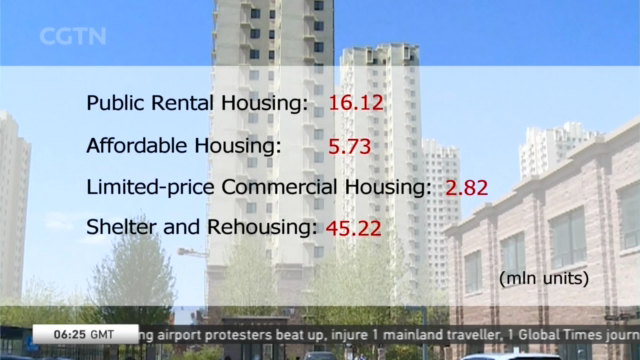
14:46, 14-Aug-2019
Public Housing Improvements: China helps some 200 million people improve housing conditions
Updated
14:54, 14-Aug-2019

As China adds to its ever-growing supply of public housing, the nation's goals are no longer just to get homeless people into these buildings. Housing conditions and quality of life are improving, even for the lowest-income residents. This new trend is also changing the stigma of public housing, and making such dwellings more attractive to tenants. CGTN reporter Ning Hong explains.
Over the past 40 years, nearly 200 million people in China have seen their living conditions improve.
This is according to the latest statistics from the Ministry of Housing and Urban-Rural Development.
They say the numbers are largely thanks to a quarter century of building public housing.
LIU HONGYU, DIRECTOR REAL ESTATE RESEARCH INSTITUTE, TSINGHUA UNIVERSITY "From 1994 to 2007, more than 10 million affordable housing units were built, and from 2008 to 2018, about 70 million more came along. The share of all types of public housing is about 24% of China's housing stock. This is a great achievement."
The conditions of these and other types of housing in China have dramatically improved since the 1980s.
Among the 70 million units of public housing nationwide: 16.12 million are rental properties (including low-rent housing), 5.73 million fall under affordable housing, 2.82 million are limited-price commercial dwellings, and 45.22 million units are made up of shelters and rehousing facilities.
The transformation of shantytowns in cities has played a major part.
However, the policy is shifting as improving living conditions is now a new focus. People in this public housing project in Beijing now enjoy upgraded facilities, including some new technologies, that aren't even used in commercial residential buildings.
HE CHAO, PROJECT DIRECTOR CHANG YING NEIGHBORHOOD. BEIJING "We introduced facial recognition access controls to improve the security of the neighborhood. We also built a commercial district, a primary school, a police station and a nursing home."
In cities such as Beijing, many residents come from other regions of China.
Li Shuqin moved to Beijing years ago. She pays two thousand Yuan a month, one third of the average price in this district.
LI SHUQIN LOCAL RESIDENT "My pension is not much. I could live here as long as I want. It is a very good neighborhood."
By the end of 2018, more than 37 million Chinese were living in public housing, and nearly 22 million people were receiving public rental subsidies.
China's efforts continue with more planned public housing. Construction began on 1.8 million new units in the first two quarters of the year, which is over half the annual plan. Many of them will come with joint property rights and rental regulations.
Ning Hong, CGTN.Beijing.
SITEMAP
Copyright © 2018 CGTN. Beijing ICP prepared NO.16065310-3
Copyright © 2018 CGTN. Beijing ICP prepared NO.16065310-3